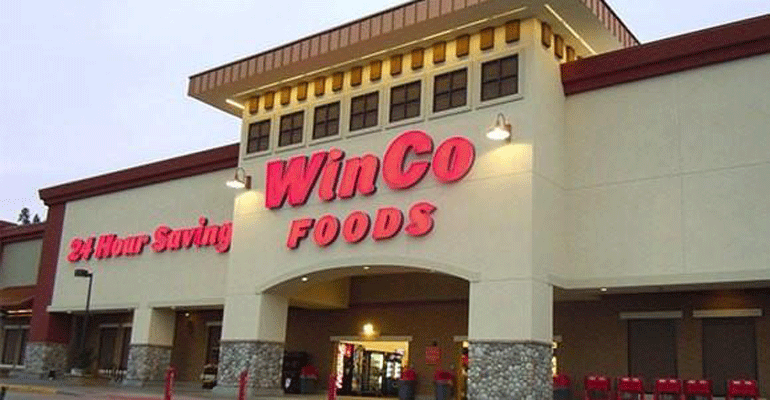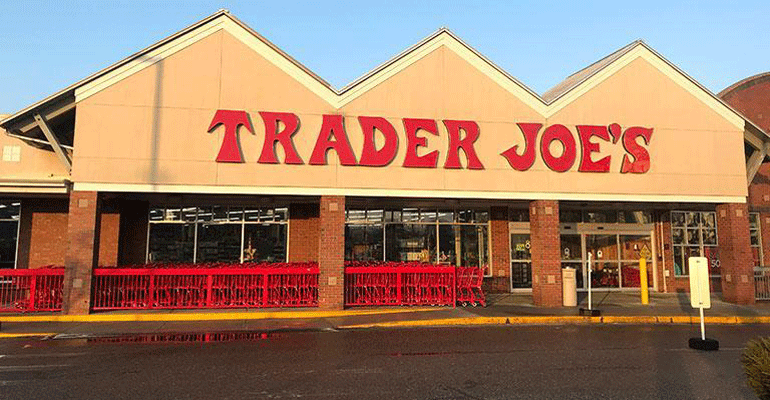Trader Joe’s, Costco Wholesale, Amazon, H-E-B and Wegmans Food Markets finished as the top five grocery retailers in dunnhumby’s second annual Retailer Preference Index (RPI).
In a survey of 7,000 U.S. households, the RPI examined the 56 largest retailers in the $700 billion U.S. grocery market to determine which have the strongest combination of consumer emotional sentiment and financial performance. This year’s results, released Wednesday, had Trader Joe’s in the No. 1 spot on the index for the second year.
Rounding out the grocery retailers with the highest overall consumer preference index scores were Market Basket (No. 6), Sam’s Club (No. 7), Sprouts Farmers Markets (No. 8), WinCo Foods (No. 9), Walmart (No. 10), Aldi (No. 11), Peapod (No. 12) and The Fresh Market (No. 13).
For the ranking, dunnhumby zeroed in on seven “pillars” shaping the consumer emotional connection to and the financial performance of a particular grocery retailer: price; quality; digital; operations; discounts, rewards and information; convenience; and speed.
The Chicago-based customer data specialist said retailers who focus on superior value perception — that is, the strongest blend of price and quality — tend to have the strongest emotional bond with consumers and the most financial success.
“Because of pressures that grocery retailers are facing today, a common reaction is to think only of the short term,” Jose Gomes, president of North America for dunnhumby, said in a statement. “But by focusing on the customer preference levers that we have identified in this RPI to inform their strategies, retailers can buy an insurance policy for the future to ensure they can weather the storms ahead.”
The top retailers on the index are mostly nontraditional grocers that have developed a highly targeted offering to bolster the value perception for their customer base. “More traditional, regional grocery banners with a long history are hurting because of it, having relatively poorer-performing financials and/or emotional bonds. The reason: These traditional banners have inferior price perception and/or quality,” dunnhumby said in the report.
Trader Joe’s succeeds by continuing to be “excellent at what matters most to their customers,” despite pursuing a brick-and-mortar strategy over digital and having a limited assortment, especially in non-food items, according to the RPI study.
“Trader Joe’s is a prime example of a retailer making trade-offs in order to deliver superior value, and it has earned them the top spot in our rankings two years in a row,” dunnhumby said. “With its small format, lack of digital shopping and limited national-brand offering, the retailer focuses on speed of in-store shopping and having a rich private-brand offering. This bricks-and-mortar-only, private-brand approach minimizes costs and keeps prices low, allowing them to pad margins and reinvest in customer service, product quality and in-store experience.”
Checking in on price
For the RPI pillar of price, consumers seek retailers with pricing lower than other stores but fair in organic/natural items, the study said. The top five grocery retailers in price on the index were Aldi, Market Basket, WinCo, Food4Less and Costco.

WinCo was ninth overall on the index and got high marks in price, operations and convenience.
“Amazon and Walmart have a proven ability to flex their economies of scale and undercut prices of the competition and will likely respond similarly to an Aldi and Lidl expansion. Given that Aldi can flex back with their own powerful and growing economies of scale, retailers who cannot engage in this back-and-forth must find their own ways to address price and value perception or become collateral damage,” the report said.
Dunnhumby noted that Lidl, eyeing a U.S. expansion, has pushed other grocers to drop prices 10% to 50% in markets it has entered, while Costco may turn up the heat on the pricing front. “Costco’s CFO has expressed an urge to be first to market when it comes to price drops and will likely look to cover or beat the moves of Amazon, Walmart and competitive entrants,” said the study.
Quality counts
In the area of quality, customers look for product freshness and variety, a strong private label, prepared food and natural/organic offerings as well as a compelling store experience, according to dunnhumby. That includes customer service, cleanliness and a shopping environment with an upscale feel. Leading the field in quality on this year’s RPI were Wegmans, The Fresh Market, Trader Joe’s, Publix Super Markets and Sprouts.
“Shoppers do not generally distinguish between the quality of the assortment and the quality of the store experience. As a result, it is very hard for a retailer to have high quality marks on one but not the other,” dunnhumby explained in the report. “This means that to improve the quality perception of their assortment, they must also improve the quality perception of their store experience. Stores that do this win the quality perception game.”

Wegmans topped all grocery retailers in terms of quality.
Similarly, private labels correlate strongly to quality and price. Dunnhumby cited H-E-B as one traditional supermarket chain succeeding in this area, noting that its store-brand scores equal those of private-brand leaders like Costco and Trader Joe’s.
“A private brand with an entry price point or simply a price point that is clearly competitive to the national brand can bring a positive price halo to the store image. It can act as a branding vehicle, representing who the retailer is to its customers and satisfying their need to shop somewhere that shares their values,” the study said. “Branding is one opportunity for traditional, regional grocers to evolve beyond a reliance on letting the store speak for itself.”
Digital experience
The main drivers of consumer preference in digital are whether a retailer provides easy ways to shop online or via a mobile app and sends shoppers useful information, dunnhumby’s analysis found. The top winners in digital on the index were Amazon, Target, Peapod, Walmart and Sam’s Club.
Retailers with the best digital experience were either thriving financially or “treading water,” the report said. Though both groups deliver superior websites and/or apps, the five-year grocery sales compound annual growth rate for thrivers averaged 11.1%, whereas the CAGR for those treading water averaged 0.02%.

H-E-B was cited as a leader in quality and price, fueled by a strong private-label program.
“The call to action for any retailer investing in digital is to ensure that they have a well-priced offering of digitally in-demand, center store products as well as the scale within its footprint to reach a wide audience. Otherwise, digital as an amplifier of financial success is in doubt,” the study noted.
Retailers leading the index in operations — Market Basket, WinCo, BJ’s Wholesale Club, Publix and Costco — are adept at reducing out-of-stocks, pricing consistently, maintaining clean stores and offering the right product variety for their customer base. But dunnhumby warned that the rising importance of digital can distract grocery retailers’ focus from these areas.
“Retailers who tended to see improvements in their digital rank also tended to see slips in their operations,” the report said. “Retailers that ramp up investment in digital must be cautious not to take their eye off the retail basics.”
The shopper experience
Relevancy and ease of redemption are the keys to retailer success in discounts, coupons and shopper rewards, the study found. Four of the top five retailers in this area on dunnhumby’s RPI were Kroger Co. banners (Fry’s, Kroger, King Soopers and Smith’s), with the other being Price Chopper.
To win over customers and succeed financially with deals, offers and rewards, retailers must focus on personalization “to point shoppers in the right direction” rather than “throw a lot of money at discounts and promotions just to make sure some of them stick,” the report pointed out.
“For some traditional, regional grocers, discounts/rewards and promotions are contributing to sales growth, but for many this is adding to financial difficulty,” dunnhumby explained. “In the U.S., hundreds of millions of dollars are spent on discounts, rewards and promotions every year, but over two-thirds of promotions don’t break even. To maximize the success of a discounts/rewards program, retailers need to have at least average price perception and a highly relevant assortment, supported by a strong private brand.”
Walmart and its Neighborhood Market stores, Publix, Market Basket and Albertsons Cos.’ Jewel-Osco banner were the top retailers in convenience, defined in the study as convenient locations and the ability for customers to do all their shopping at one store.

Aldi finished first in the index on pricing.
“Convenience can help keep a retailer afloat. With enough locations and products, customers can’t help but be captive to visiting those stores for at least some products, especially if they have built up a habit of doing so,” the report said.
And related to consumer preference for convenience is the RPI pillar of speed in the shopping visit, or the ability to easily enter and exit a store — or make an online order — and then check out quickly. Amazon, unsurprisingly, ranked No. 1 in speed among consumers surveyed, followed by Aldi, Publix, Brookshire Food & Pharmacy and The Fresh Market.
“Retailers have continued, over many years, to experiment with format reinvention to keep up with shifts to urban centers, preference for the conveniences offered by new digital shopping habits, pressures to lower costs and the overarching goal of improving customer experience,” dunnhumby said in the report. “From Amazon Go’s cashierless stores and resulting interest in Just Walk Out technology on the part of competitors, to many retailers experimenting with smaller formats or other ways to speed up checkout, the innovations reflect shoppers’ need for speed and desire for time savings that frictionless shopping provides.”





